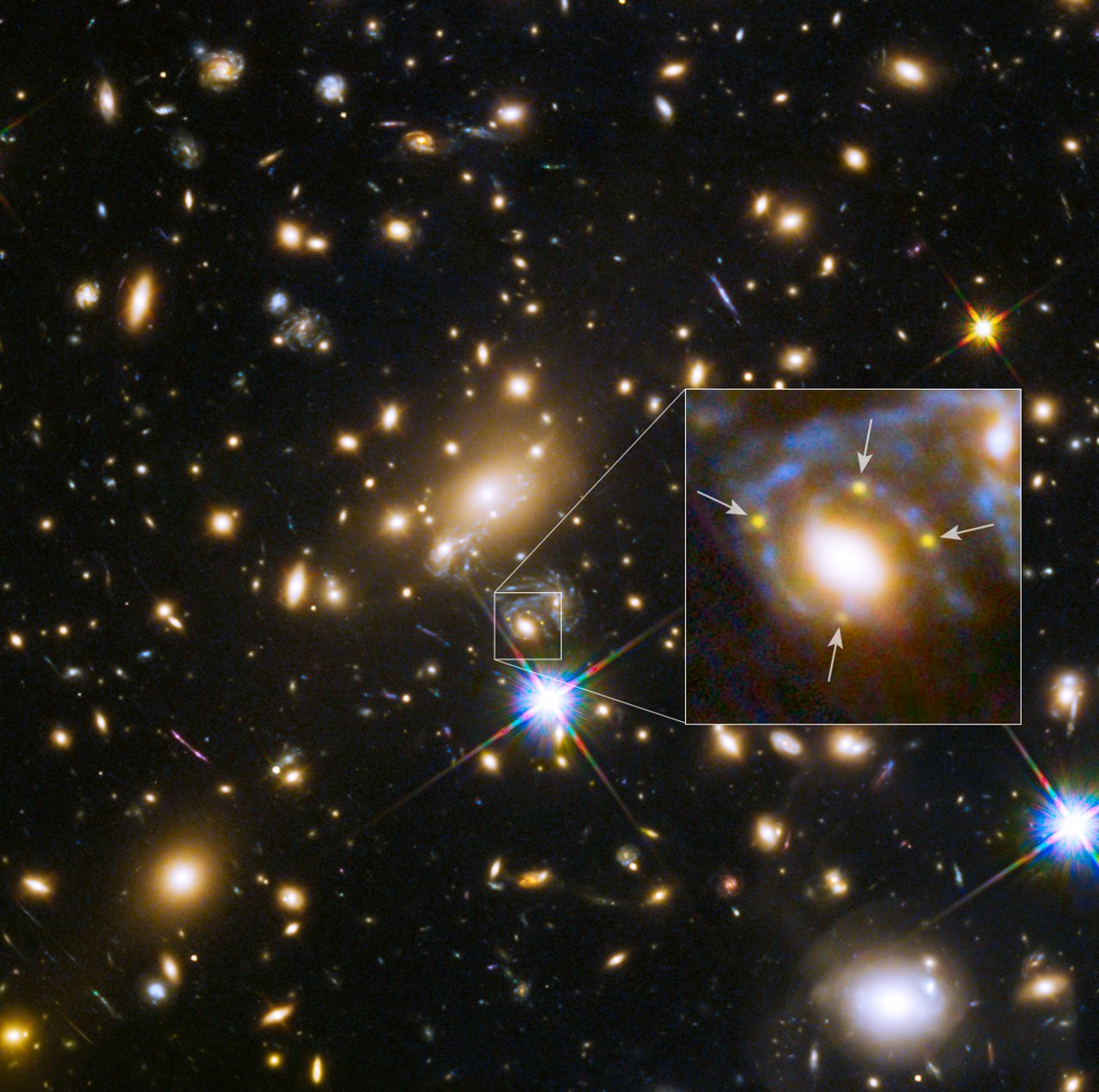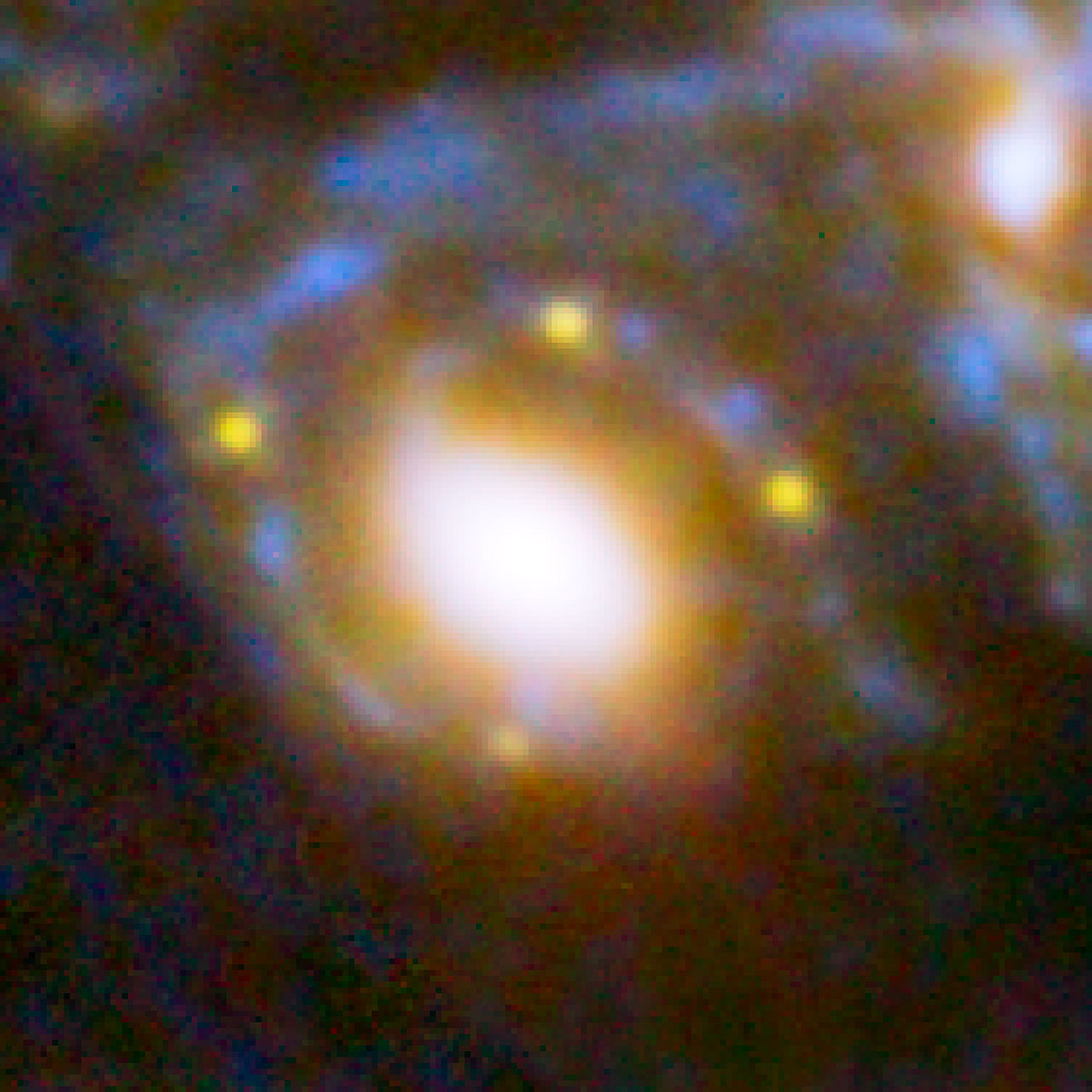Find out the latest thinking about our universe.
-
bystander
- Apathetic Retiree
- Posts: 21577
- Joined: Mon Aug 28, 2006 2:06 pm
- Location: Oklahoma
Post
by bystander » Thu Mar 05, 2015 9:12 pm
An explosive quartet
ESA Hubble Science Release | 2015 Mar 05
Hubble sees multiple images of a supernova for the very first time
Astronomers using the NASA/ESA Hubble Space Telescope have, for the first time, spotted four images of a distant exploding star. The images are arranged in a cross-shaped pattern by the powerful gravity of a foreground galaxy embedded in a massive cluster of galaxies. The supernova discovery paper will appear on 6 March 2015 in a special issue of
Science celebrating the centenary of Albert Einstein’s theory of general relativity.
Whilst looking closely at a massive elliptical galaxy and its associated galaxy cluster
MACS J1149+2223 — whose light took over 5 billion years to reach us — astronomers have spotted a strange and rare sight. The huge mass of the galaxy and the cluster is bending the light from a much more distant supernova behind them and creating four separate images of it. The light has been magnified and distorted due to gravitational lensing and as a result the images are arranged around the elliptical galaxy in a formation known as an Einstein cross.
Although astronomers have discovered dozens of multiply imaged galaxies and quasars, they have never before seen multiple images of a stellar explosion. ...
This unique observation will help astronomers refine their estimates of the amount and distribution of dark matter in the lensing galaxy and cluster. There is more dark matter in the Universe than visible matter, but it is extremely elusive and is only known to exist via its gravitational effects on the visible Universe, so the lensing effects of a galaxy or galaxy cluster are a big clue to the amount of dark matter it contains.
When the four supernova images fade away as the explosion dies down, astronomers will have a rare chance to catch a rerun of the explosion. The supernova images do not arrive at the Earth at the same time because, for each image produced, the light takes a different route. Each route has a different layout of matter — both dark and visible — along its path. this causes bends in the road, and so for some routes the light takes longer to reach us than for others. Astronomers can use their model of how much dark matter is in the cluster, and where it is, to predict when the next image will appear as well as using the time delays they observe to make the mass models even more accurate. ...
Multiple Images of a Highly Magnified Supernova Formed by an Early-Type Cluster Galaxy Lens - Patrick L. Kelly
et al
Hubble Sees Supernova Split into Four Images by Cosmic Lens
NASA | STScI | HubbleSite | 2015 Mar 05
Distant supernova split four ways by gravitational lens
University of California, Berkeley | 2015 Mar 05
First discovery of a distant star exploding into a supernova
University of California, Los Angeles | 2015 Mar 05
Supernova Split into Four Images by Cosmic Lens
W.M. Keck Observatory | 2015 Mar 05
Astronomers observe four images of the same supernova
Niels Bohr Institute | 2015 Mar 05
Rare Split Images of Supernova Put Astronomer in Spotlight
Johns Hopkins University | 2015 Mar 10
Know the quiet place within your heart and touch the rainbow of possibility; be
alive to the gentle breeze of communication, and please stop being such a jerk. — Garrison Keillor
-
bystander
- Apathetic Retiree
- Posts: 21577
- Joined: Mon Aug 28, 2006 2:06 pm
- Location: Oklahoma
Post
by bystander » Fri Nov 13, 2015 5:52 pm
Astronomers get once-in-a-lifetime opportunity to predict supernova
ESA Hubble Announcement | 2015 Nov 13
A serendipitous observation of a distant supernova by the NASA/ESA Hubble Space Telescope is providing astronomers with a once-in-a-lifetime opportunity to definitively test their understanding of massive clusters of galaxies.
In November 2014 astronomers spotted a strange and rare sight. The huge mass of the galaxy cluster
MACS J1149+2223 was magnifying the light from a much more distant supernova behind it, nicknamed Refsdal.
The light from Refsdal was magnified and distorted due to
gravitational lensing, creating four separate images of the supernova arranged in a formation known as an
Einstein Cross. Although astronomers have discovered dozens of multiply imaged galaxies, they had never before seen multiple images of a supernova (
heic1505).
The four supernova images have been slowly fading away as the explosion dies down, but astronomers now have the unique chance to catch a rerun of Refsdal: The supernova images do not arrive on Earth at the same time because, for each image produced, the light takes a different route. For some of these routes, the light takes longer to reach us than for others.
Using various models of the cluster acting as a lens, astronomers have made a consistent set of predictions for when the next image will appear. Hubble’s gaze will now periodically be fixed on the skies in anticipation of once again observing Refsdal. The next image of this extraordinary event is expected to peak in the first third of 2016.
Follow the progress of Hubble’s upcoming observations on social media, on Hubble’s
Twitter and
Facebook pages. Stay tuned!
Know the quiet place within your heart and touch the rainbow of possibility; be
alive to the gentle breeze of communication, and please stop being such a jerk. — Garrison Keillor
-
bystander
- Apathetic Retiree
- Posts: 21577
- Joined: Mon Aug 28, 2006 2:06 pm
- Location: Oklahoma
Post
by bystander » Wed Nov 25, 2015 8:33 pm
MUSE Observations Enable Prediction of Once-in-a-lifetime Supernova Replay
ESO Announcement | VLT | MUSE | 2015 Nov 25
Astronomers have used the Multi Unit Spectroscopic Explorer (
MUSE), attached to ESO’s Very Large Telescope (
VLT) at the Paranal Observatory, to take advantage of a once-in-a-lifetime opportunity to test their understanding of massive clusters of galaxies. They are making the first ever prediction of an observational event in the distant Universe before it actually becomes visible. ...
Using all the available MUSE data, in combination with Hubble observations, a team of astronomers led by Claudio Grillo (Dark Cosmology Centre, Niels Bohr Institute, University of Copenhagen, Denmark) have predicted that a further replay will peak in brightness between March and June 2016, with a possible first detection before the end of 2015. They can also anticipate not only where and when the supernova is expected to become visible again, but also approximately how bright it will appear. ...
The story of supernova 'Refsdal' told by MUSE - C. Grillo
et al
Refsdal' meets Popper: comparing predictions of the re-appearance
of the multiply imaged supernova behind MACS1149.5+2223 - T. Treu
et al
Hubble Frontier Fields: Predictions for the Return of SN Refsdal with the MUSE and GMOS Spectrographs - M. Jauzac
et al
A highly-ionized region surrounding SN Refsdal revealed by MUSE - W. Karman
et al
http://asterisk.apod.com/viewtopic.php?t=35092
http://asterisk.apod.com/viewtopic.php?t=34526
Know the quiet place within your heart and touch the rainbow of possibility; be
alive to the gentle breeze of communication, and please stop being such a jerk. — Garrison Keillor
-
BMAONE23
- Commentator Model 1.23
- Posts: 4076
- Joined: Wed Feb 23, 2005 6:55 pm
- Location: California
Post
by BMAONE23 » Wed Nov 25, 2015 10:28 pm
Interestingly, in the Highlighted image which states "the uppermost circle shows the position of the supernova as it could have been seen in 1995."
The uppermost circle is around a particular galaxy. This galaxy appears to be the same galaxy that looks like it is smashed up against the 2014 discovery location (bottom circle) at 1:30 position relative to the bottom circle
-
bystander
- Apathetic Retiree
- Posts: 21577
- Joined: Mon Aug 28, 2006 2:06 pm
- Location: Oklahoma
Post
by bystander » Wed Dec 16, 2015 5:27 pm
Refsdal: Caught in the Act
ESA Hubble Science Release | 2015 Dec 16
Hubble captures first-ever predicted exploding star
The NASA/ESA Hubble Space Telescope has captured the image of the first-ever predicted supernova explosion. The reappearance of the Refsdal supernova was calculated from different models of the galaxy cluster whose immense gravity is warping the supernova’s light.
Many stars end their lives with a with a bang, but only a few of these stellar explosions have been caught in the act. When they are, spotting them successfully has been down to pure luck — until now. On 11 December 2015 astronomers not only imaged a supernova in action, but saw it when and where they had predicted it would be.
The supernova, nicknamed Refsdal
[1], has been spotted in the galaxy cluster
MACS J1149.5+2223. While the light from the cluster has taken about five billion years to reach us, the supernova itself exploded much earlier, nearly 10 billion years ago
[2].
Refsdal’s story began in November 2014 when scientists spotted four separate images of the supernova in a rare arrangement known as an
Einstein Cross around a galaxy within MACS J1149.5+2223 (
heic1505)
[3]. The cosmic optical illusion was due to the mass of a single galaxy within the cluster warping and magnifying the light from the distant stellar explosion in a process known as gravitational lensing
[4]. ...
Caught in the Act: Hubble Captures First-Ever Predicted Exploding Star
NASA | STScI | HubbleSite | 2015 Dec 16
Deja Vu All Over Again: The Reappearance of Supernova Refsdal - P. L. Kelly
et al
Know the quiet place within your heart and touch the rainbow of possibility; be
alive to the gentle breeze of communication, and please stop being such a jerk. — Garrison Keillor



